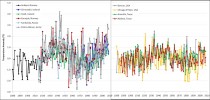Guest post by Verity Jones, Watts Up With That
Man is not the primary cause of change in the Arctic says book by Russian scientists.
Forget the orthodox view of Arctic climate change - this book has a very different message. (h/t to WUWT commenter Enneagram)
Published last year, this is a synthesis of work by the Russian Arctic and Antarctic Research Institute (AARI). It sets out the data and experience of scientists over 85 years, drawing together much already published in the area. For a book that is billed under a climate change heading, this is actually more an antidote to the hype usually associated with warming in the Arctic. A few pages of each chapter are available on-line and even that is well worth reading; no doubt even better in its entirety.
The Preface sets the tone of the book very clearly - “...scientists have predicted a significant decrease in sea-ice extent in the Arctic and even its complete disappearance in the summertime by the end of the 21st century. This monograph presents results of studies of climatic system changes in the Arctic, focused on ice cover, that do not justify such extreme conclusions.” “Many studies and international projects, such as the Arctic Climate Impact Assessment (ACIA), attribute the air temperature increase during the last quarter of the 20th century exclusively to accumulation of greenhouse gases in the atmosphere. However these studies typically do not account for natural hydrometeorological fluctuations whose effects on multiyear variability, as this monograph shows, can far exceed the anthropogenic impact on climate.”
The book begins by examining the major effects of the Polar Ice caps and their overall stability on Earth’s climate - affecting albedo, and regulating the heat flux from the sea to atmosphere. Climate variations are discussed and the WMO’s “30 year average” definition of climate is not considered applicable in the Arctic because fluctuations in the polar climate are so large.
Chapter 2 looks at what is known about changes in sea ice in the 20th century. The Russian data sets probably hold the most extensive information available for the first half of the century due to interest in the Northern Sea Route in the 1930s. In addition, measurements of ice thickness also go back to the middle of the 1930s when they were taken regularly for coast-bound ice at many of the Polar stations.
It is particularly interesting what they say about Arctic air temperatures (Chapter 4). “Periodic cooling and warming events are evident in air temperature fluctuations in the Arctic during the 20th century, similar to changes in ice cover.” A cool period at the beginning of the 20th century was followed by what is commonly referred to as the “Arctic Warming Period” in the 1920s-1940s. Relative cooling was widespread between the late 1950s to late 1970s, followed by the current warming period peaking in recent years. Gridded average temperature anomalies for 70-85N produce a curve that fits a polynomial trend to the sixth power and the cycle periodicity is 50-60 years (Figure 4.1). Other indicators in Arctic and Antarctic support this cycle and show its global nature. On the subject of polar amplification, whereby weather and climate variability increase with latitude, a number of models and explanations are discussed. None of these involve CO2.

Cyclic temperature for Arctic stations in the GHCNv2 dataset enlarged here (originally posted here).
The authors point out there is an abundance of hypotheses as to the possible causes of climate and ice variation and climate change (a ‘long-term’ phenomenon) but these lack detailed long-term data. They state “where data do exist, we should prefer data to computer models”; they believe model projections of future ice area fluctuations are unreliable. Actually, they have some deliciously scathing remarks about climate models.
“The models neglect natural fluctuations because they have no means of incorporating them, and put the entire blame for climate changes since the 19th century on human activity.”
On possible future changes they predict that “..in the 21st century, oscillatory (rather than unidirectional) ice extent changes will continue to dominate Arctic seas.” A new ice maximum in 2030-2035 is predicted (Figure 6.1) and this will have major implications for shipping in the region.
From the results of spectral analyses, they conclude that there are 50-60 year cycles and less prevalent ones at 20 years, 8-12 years and 2-3 years. These are closely related to variations in general atmospheric circulation. In the longer term the decreasing trend of ice extent may be a segment of a 200 year cyclic variation responsible for the Medieval Warm Period and Little Ice Age. Much of the discussion about solar effects is behind the paywall for the book, however there are some strong conclusions about solar effects on Arctic climate. Despite the small variation in Total Solar irradiance (TSI) through solar cycles, solar activity may have a greater effect on high latitudes because of interaction with the Earth’s magnetic field. Solar system “dissymmetry” (barycentre) influences are also mentioned as closely corresponding to the 60 year cycles.
The authors conclude that the simulation by the general circulation models does not appear to reflect the cyclic features in Arctic ice extent and climate, and, if their cyclic interpretations of climate variation are correct, ice cover will continue to fluctuate as there is little connection with the anthropogenic burning of fossil fuels.
Climate Change in Eurasian Arctic Shelf Seas: Centennial Ice Cover Observations. Authors: Ivan E. Frolov, Zalmann M. Gudkovich, Valery P. Karklin, Evgeny G. Kovalev, and Vasily M. Smolyanitsky. Published by Springer/Praxis (2009) ISBN 9783540858744
See post here. See Verity’s Digging in the Clay site here.


